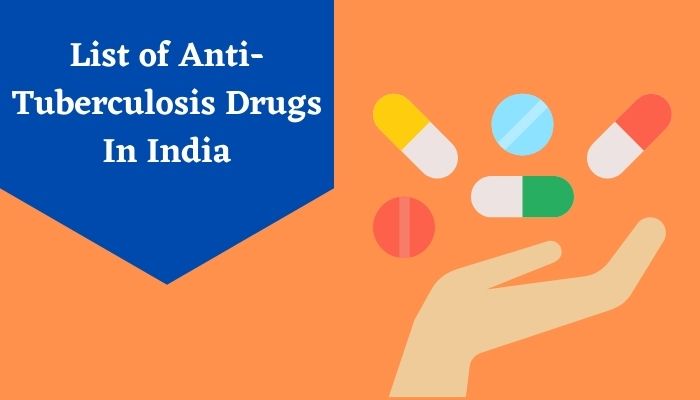Tuberculosis is a dangerous disease caused by the Mycobacterium tuberculosis bacteria or MTB. It is an acid-fast microorganism that infiltrates the body and majorly affects your lungs but can spread to other parts of the body too. It has a lot of painful list of symptoms and is infectious in nature if you come in contact with someone who has TB.
Up until a century ago, Tuberculosis was referred to as Consumption and patients were outcast to prevent spreading the bacteria. Anyone could contract the disease from micro-droplets coming in contact through talking, sneezing, coughing, etc. and at the time it was untreatable.
Fortunately, it is a curable disease now. If you seek treatment in the early days then you can keep it from spreading through your body such as the brain, kidney, etc. The process involves taking anti-tuberculosis drugs that help kill the bacteria over time. However, the anti-tuberculosis drugs are determined based on the severity of the infection and whether it is latent or active in the patient’s body.
What is an Anti-Tuberculosis drug?
Anti-tuberculosis drugs are FDA-approved medications that are used to treat tuberculosis infections in people. The anti-tuberculosis drugs used for treating the bacterial infection are dependent on whether the bacteria are active in the host body or if it is latent at the moment.What is anti-tuberculosis drugs classification?
Anti-tuberculosis drugs are classified as the First line of drugs, second line of drugs, and MDR-TB drugs. Below is the list of the drugs that are used for treatment based on their categories.First-line anti-tuberculosis drugs
- Ethambutol – It prevents biosynthesis in the cell wall of the mycobacteria and inhibits the arabinosyltransferase enzyme.
- Rifampin – It reversibly inhibits the RNA polymerase that is DNA-dependent to synthesize bacterial protein.
- Pyrazinamide – It inhibits the trans-translation of active pyrazinoic acid.
- Isoniazid – It inhibits the biosynthesis of mycolic acid.
Aminoglycosides:
- Amikacin – It inhibits protein synthesis of the mycobacteria by binding to the 30S ribosome subunits.
- Kanamycin - It has similar effects as Amikacin such that it also inhibits protein synthesis of the mycobacteria through binding itself to the 30S subunits of the ribosome.
- Streptomycin – It has similar effects to Amikacin and Kanamycin of inhibiting protein synthesis in the mycobacteria by binding itself to the ribosome 30S subunits.
- Gatifloxacin – It affects the inhibition of topoisomerase IV and DNA gyrase for DNA synthesis in bacteria.
- Levofloxacin - It inhibits topoisomerase IV and DNA gyrase for DNA synthesis in the bacteria, much like Gatifloxacin.
- Moxifloxacin - It affects the inhibition of DNA synthesis in the bacteria with topoisomerase IV and DNA gyrase.
- Delamanid
- Bedaquiline
- Pretomanid
- Linezolid
Anti-tuberculosis drugs dosage and side effects
First-line drugs1. Ethambutol
- Anti-tuberculosis drugs dosage: the dosage is prescribed as per the weight of the person as 25mg per kg.
- Anti-tuberculosis drugs side effects: Hepatotoxicity and Optic Neuropathy.
- Anti-tuberculosis drugs dosage: dosage is calculated as 10mg per kg of the patient’s overall weight up to 600mg max
- Anti-tuberculosis drugs side effects: CYP450 inducer, discolouration of bodily fluids to red or orange, Thrombocytopenia, Hepatotoxicity, and Neutropenia.
- Anti-tuberculosis drugs dosage: the dosage depends on the weight of the patient, calculated as 25mg per kg
- Anti-tuberculosis drugs side effects: Arthralgia, Hepatotoxicity, and Hyperuricemia.
- Anti-tuberculosis drugs dosage: dosage is determined by the weight of the individual as 5mg per kg up to 300 mg max
- Anti-tuberculosis drugs side effects: Hepatotoxicity, peripheral neuropathy, and deficiency of Vitamin B6.
The second line of anti-tuberculosis drugs is given to patients as injections if they are resistant to the first line of drugs. They may, however, exhibit side effects as follows:
Anti-tuberculosis drugs side effects of Aminoglycosides: Nephrotoxicity and Ototoxicity
Anti-tuberculosis drugs side effects of Fluoroquinolones: Arthropathy, Tendonitis, and Rupture of the Tendons
Using the anti-tuberculosis drugs to treat a patient during pregnancy is fine, however, you must not take Aminoglycosides. If you are prescribed any of the Aminoglycosides, it is ideal to speak with your doctor to change the medication. This is because these second-line anti-tuberculosis drugs may transmit ototoxicity to the fetus.
Additionally, since all the first-line anti-tuberculosis drugs have side effects of hepatotoxicity, it is ideal to periodically go for a checkup of the liver.
Conclusion
Tuberculosis treatment using anti-tuberculosis drugs is an intense process. Doctors usually start with first-line treatment. If the patient is resistant to the first-line anti-tuberculosis drugs, they will substitute them with the second line. If both lines exhibit strong resistance, then the MDR-TB drugs come into the picture.You need to go for regular checkups in order to ensure that the prescribed drugs are working for you as well as to make sure that the treatment progression is unhindered.


